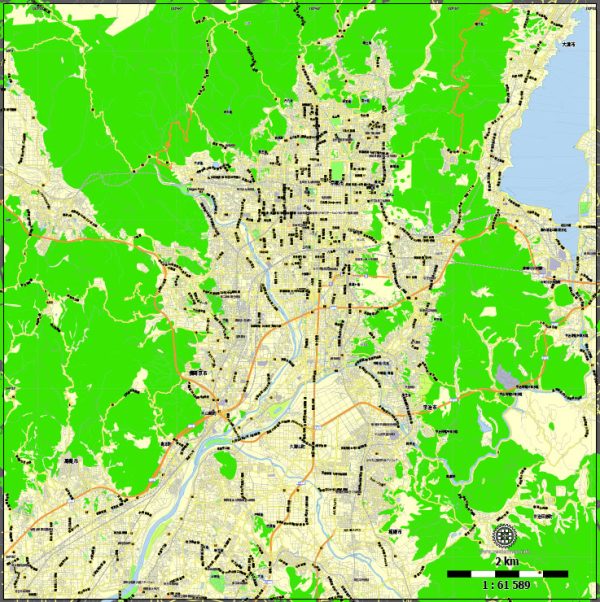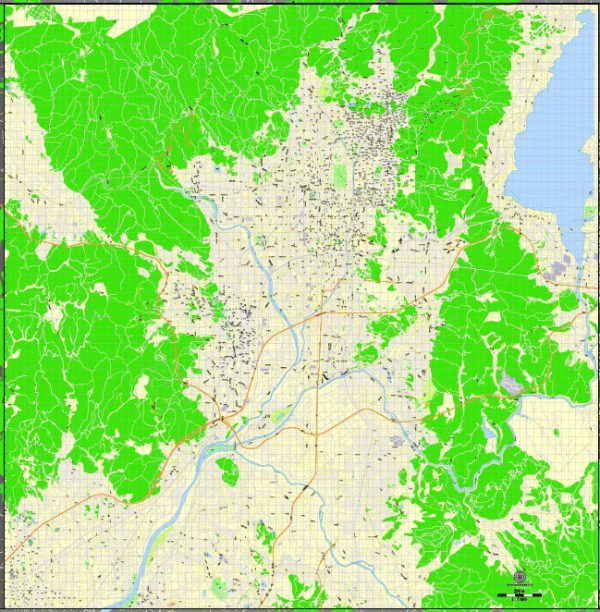Kyoto is a city with a rich tapestry of districts and neighborhoods, each offering its own unique atmosphere, attractions, and cultural experiences.
Vectormap.Net provide you with the most accurate and up-to-date vector maps in Adobe Illustrator, PDF and other formats, designed for editing and printing. Please read the vector map descriptions carefully.
Here’s a brief overview of some prominent districts and neighborhoods in Kyoto:
1. Gion:
- Description: Gion is Kyoto’s most famous geisha district, known for its preserved historic streets, traditional wooden machiya houses, and the presence of geisha and maiko. It is a charming area with narrow lanes, teahouses, and exclusive restaurants.
- Attractions: Yasaka Shrine, Hanami-Koji Street, Gion Corner (for traditional performances), and the Shirakawa Area.
2. Higashiyama:
- Description: Located in eastern Kyoto, Higashiyama is characterized by its well-preserved historic streets and traditional machiya architecture. It is home to numerous temples and shrines, creating a quintessential Kyoto atmosphere.
- Attractions: Kiyomizu-dera, Yasaka Pagoda, Sannenzaka, and Ninenzaka.
3. Arashiyama:
- Description: Situated in the western outskirts of Kyoto, Arashiyama is famous for its bamboo groves, scenic river views, and historical sites. It offers a more natural and relaxed setting compared to the urban areas.
- Attractions: Arashiyama Bamboo Grove, Iwatayama Monkey Park, Togetsukyo Bridge, and Tenryu-ji Temple.
4. Downtown Kyoto (Shijo-Kawaramachi):
- Description: This bustling downtown area is the commercial and entertainment hub of Kyoto. It features modern shopping centers, department stores, and a vibrant nightlife scene. The Shijo-Kawaramachi intersection is a major landmark.
- Attractions: Nishiki Market, Pontocho Alley (for dining and nightlife), and Teramachi and Shinkyogoku Shopping Streets.
5. Kyoto Station Area:
- Description: The Kyoto Station area is a modern transportation hub with a futuristic train station and commercial complex. It offers a stark contrast to the city’s traditional districts.
- Attractions: Kyoto Station Building, Kyoto Tower, and the Kyoto Aquarium.
6. Fushimi:
- Description: Fushimi is known for its historic Fushimi Inari Taisha, famous for its thousands of red torii gates. The area also has sake breweries and scenic canals.
- Attractions: Fushimi Inari Taisha, Fushimi Sake District, and Fushimi Momoyama Castle.
7. Nijo:
- Description: Nijo is home to Nijo Castle, a UNESCO World Heritage Site known for its “nightingale floors” and beautiful gardens. The district has a more residential and quieter feel.
- Attractions: Nijo Castle and the surrounding gardens.
8. Nakagyo:
- Description: Nakagyo is a central district known for its traditional machiya houses and historical sites. It offers a mix of modern and traditional elements.
- Attractions: Nishiki Market, Teramachi and Shinkyogoku Shopping Streets, and Nijo Castle.
9. Kita-ku (Northern Kyoto):
- Description: The northern part of Kyoto includes areas like Kitayama and Kibune. These areas offer a peaceful retreat with scenic mountain landscapes and outdoor attractions.
- Attractions: Kibune Shrine, Kurama-dera Temple, and the Kitayama area.
Each district and neighborhood in Kyoto contributes to the city’s overall charm and provides visitors with a diverse range of experiences, from historical exploration to modern urban living and natural retreats.



 Author: Kirill Shrayber, Ph.D.
Author: Kirill Shrayber, Ph.D.